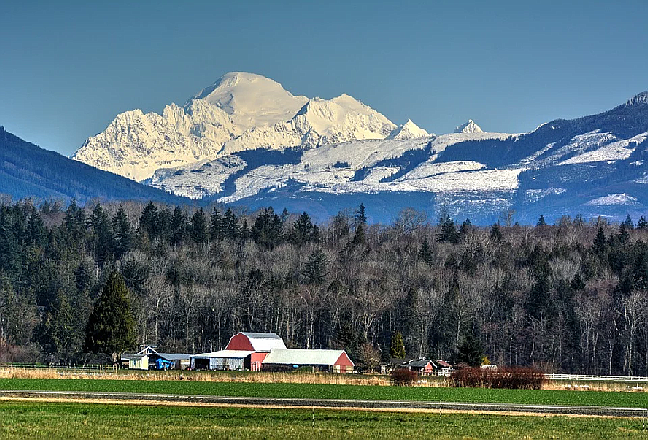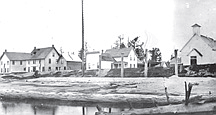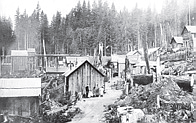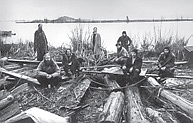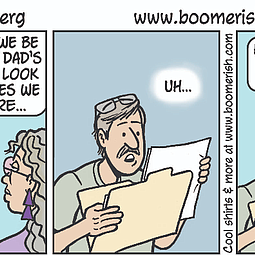The Lost Cities of Skagit
April 12, 2022 at 2:20 p.m. | Updated April 6, 2022 at 11:54 a.m.
This article has been updated. It originally appeared in April 2017
Villages, settlements and communities flourished in Skagit County’s earliest days, but many have been “lost,” or vanished, long ago. The Skagit County Historical Museum has researched these lost cities and created an interactive online map [and coming book!] of Skagit communities that have significantly changed – or virtually disappeared – during the last century.
The researching of lost cities and settlements of Skagit County has struck a chord with many people, whether they are complete newcomers to Skagit Valley or have a long history of pioneer settlement here. We all want to know why some dreams for these towns took root, others changed their original vision and still others just vanished with nothing left but a grassy field by the river. And although the people who lived in these settlements have all passed on, today we can remember their dreams and appreciate what it took to build this area out of a dense wilderness. Whether these towns lasted or disappeared, all of them played a part in shaping the county as it is today.
Many place names that appear in Skagit County’s history have since disappeared, but each has their own unique story: Skagit City, the first “metropolis” of the lower Skagit; Finn Settlement, home of saunas and cross-cut saw skates; Cokedale, the village of shacks that housed workers for a very productive coal mine, but had no peers in its unattractiveness; Deception, (later known as Fidalgo City) which was touted as the “Promised Land” and where people from thousands of miles away bought lots sight unseen; Fishtown, a historic fishing village on Skagit’s North Fork that was later settled by artists. These are just a few of Skagit County’s “Lost Cities.”
Among these are areas that once had a special character which can no longer be seen, towns where promoter’s dreams never materialized, rural communities that never became towns. Others were towns that flourished for a time and then vanished or lapsed into peaceful villages. A handful – including Anacortes, Burlington, La Conner, Mount Vernon and Sedro-Woolley – continued to grow.
The first businesses and settlements were located on waterways and were entirely dependent on them since that was the only means of travel. Railroads altered those patterns, creating new towns. The railroads increased the prosperity of some old towns and took traffic away from others. As time passed and roads and bridges were built, the improved land routes also influenced the direction of trade. As stands of virgin timber were exhausted, logging and milling moved elsewhere. Fires and floods were also factors. But no matter how they began, these early towns and settlements were all the substance of people’s dreams.
Skagit City was the largest metropolis of the Skagit area from the 1870s to the 1890s, located on the South Fork of the Skagit River below the log jams that prevented further travel upstream. It was an important stop for sternwheelers and had a school, churches, hotels, saloons and other businesses facing the riverbank. The decline of the town began with the erosion of the steep riverbank where the sternwheelers tied up. After the great log jam was finally cleared, people could then settle upriver. With the growing commercial importance of nearby Conway and the discontinuance of its ferry in 1929, the town slowly disappeared except for the school building and a road named in its honor.
Cokedale was another early settlement. Located among the foothills of the North Cascades a few miles east of Sedro-Woolley, Cokedale was also known as the Bennett Mine (in honor of the man who discovered coal there in 1878). The mine operated intermittently from 1891 to 1922 and had the only extensive quantity of high-quality coking coal in the state. A group of shacks at the mine housed 75 workers and their families. Cokedale had a population of 131 in 1900. According to the book Skagit Settlers: Trials and Triumphs, “It was unique in Skagit County for its dreary ugliness, and its disappearance left no mourners.” By the mid-1950s, the coal deposits were exhausted and the site had all but vanished. All that remained were the railroad grade, a refuse dump from the mine and coal stains on the ground.
South across the valley, several miles northeast of the town of McMurray, lay the Finn Settlement. Thirteen Finnish families settled here in the dense forest land from 1891 until the early part of the century. The residents were skilled woodworkers who built their homes of split cedar, each with its own sauna, and worked in the nearby logging camps. These Finns made and used the first skis in the county and constructed ice skates by shaping the runners from the steel of old cross-cut saws. The community was unified by its isolation, its language, its own school and by its unique traditions. By 1913, the residents could ride the railway to distant camps, and eventually roads and cars provided opportunities outside of the tiny community. As the outside world drew closer, some members moved away and non-Finns bought their homes. The group gradually lost its cohesion, but the settlement remains a warm memory.
Moving west, the settlement at the south end of Fidalgo Island just inside Deception Pass was first known as Deception (later Fidalgo City and finally renamed Dewey). In 1891, there were 341 surveyed city blocks, stores, saloons, a 40-room hotel, a mill operating full blast and six steamboats that stopped every day on their runs between Seattle and Bellingham. One settler wrote, “Fidalgo City! It’s like the Promised Land! The water wheel is over 40 feet high! Keeps the mill humming, turning out lumber. I’ll have building contracts for the rest of my life.” The national economic depression of 1893 ended those dreams, and the town with so much promise faded away. A scattering of private homes marks the area today.
According to Steve Herold, author of Where the River Ends: Art & Poetry of the Lower Skagit, Fishtown (near LaConner) “began in the 1860s when a group of fishermen built their cabins on the north bank of the North Fork near its mouth… left to go halfway to a ghost town by changes in fishing regulations.” In the 1930s, “local artists such as Guy Anderson and Clayton James discovered the broad delta and stayed. Then in the 1960s, a new generation of artists and poets showed up…Even though it was on the maps, Fishtown was next to impossible to get to unless you had a boat. It was frequently looked for by friends, and later by travelers on the hippy trail, but they were usually told, ‘it’s there, but you can’t get there from here.’ ”
For more on Skagit County’s “Lost Cities,” call 360-466-3365 or visit the Skagit County Historical Museum at 501 S. 4th Street in La Conner. You can also visit the museum’s website at www.skagitcounty.net/museum for an interactive “Lost Cities” map. If you plan to visit the museum, check out their exhibit “1968: The Year That Rocked Washington." The exhibit looks back at 1968 and its impact on Washington State, including how individuals were spurred to action college campuses, the campaign trail and evergreen peaks. 1968 showed the power of the individual to make a difference. This exhibit will be on display through May 8.
Mari C. Densmore is the archivist at the Skagit County Historical Museum. She has written articles for Peninsula Magazine, the Spokane Spokesman Review, Skagit Valley Herald, and was a former staff writer and interim editor at Target Communications.
Mari grew up in the Skagit County town of Conway and the stories of her father about the nearby towns where he used to play baseball or have other adventures. She assumed everyone knew about these "lost" cities, When she realized that others had not heard of the towns and settlements that no longer existed, that, in part, is what prompted her research. Mari is currently writing volume one of a book series on the topic of the "Lost Cities" of Skagit. The book should become available this Fall.